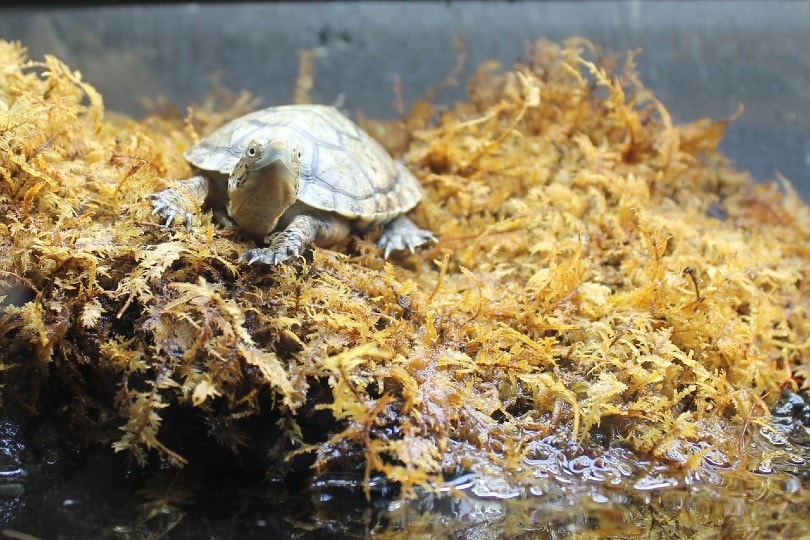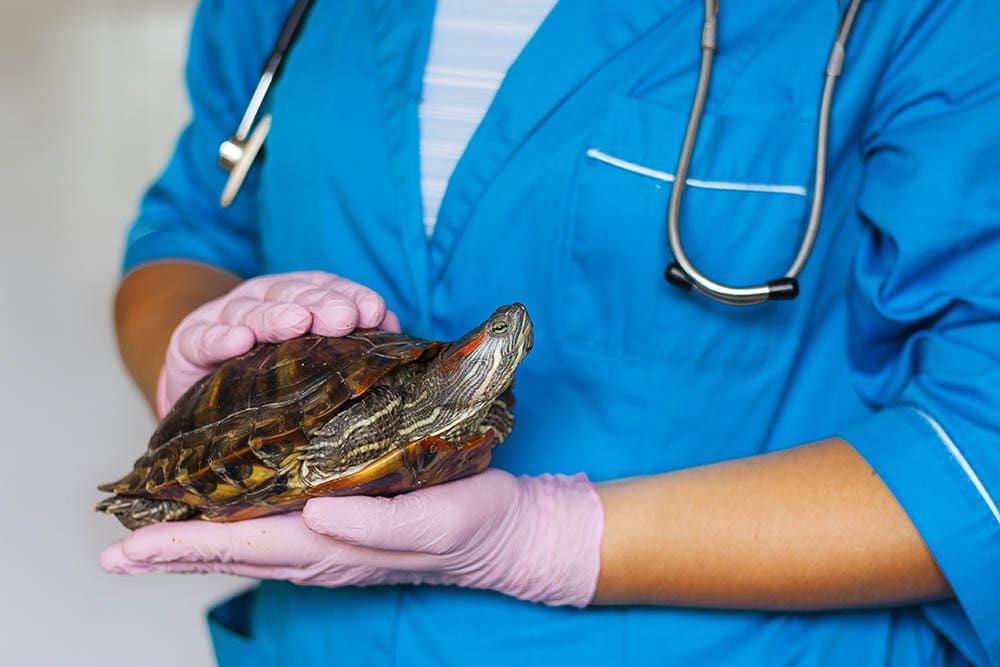
Slow-going turtles that live in a pond can be just as fun to watch as cats and dogs. Like most reptiles, they are fairly unique in terms of their nutrition. They seem to have different nutritional profiles throughout various phases of their life.
As a turtle mom or dad, you may want to make sure your baby turtle is eating the right kinds of food or to feed them a diet that best supports their growth and development. Most omnivorous freshwater baby turtles primarily eat an animal-based diet in nature, including small insects, snails, worms, and fish. As pets, turtles’ nutritional needs are somewhat similar, but care is required to keep from overfeeding them.
Keep reading as we cover in detail what baby and adult turtles eat in the wild and what you can feed them as pets, depending on your preferences. In this article, we’ll be focusing on freshwater aquatic turtles (also known as terrapins) and North American box turtles (Terrapene).
What Wild Turtles Eat

Almost all freshwater aquatic turtles are classified as omnivores. However, when they are young, their diet is heavily biased toward that of a carnivore. They consume a high amount of prey and will even opportunistically scavenge on a carcass if the opportunity presents itself. Turtles within the genus Terrapene (box turtles found all over North America) are similar in terms of their dietary preferences. Common prey include tadpoles, fish, the eggs of various animals (such as frogs), insects, slugs, other invertebrates, and any carrion that they may stumble upon.
As these turtles mature into adults, their diet tends to shift, and they tend to gradually increase the amount of plant-based foods in their diet. In some circumstances, certain species tend to be almost exclusively herbivorous as adults, deriving up to 95% of their nutrition from plants.
Such a phenomenon is also referred to as an ontogenetic shift. The precise reasons for this change aren’t yet definitely determined by researchers. However, a few theories for this shift postulate the following reasons.
What Baby Pet Turtles Eat

It is crucial that you check local laws before adopting a new turtle species. In some countries, there are laws against adopting turtles that are under a particular size. In the U.S., the FDA prohibits the sale of turtles with shells smaller than 4 inches (10 cm).
A general consensus is that juvenile turtles require more protein than adult turtles do. It is estimated that the juvenile turtles of such species may require up to 55% protein from animal sources for proper growth and development. However, such high proportions of protein must be balanced with a low-fat content. Assuming a protein rating of over 50% in the food offered to a juvenile turtle, the diet should have under 15% fat.
In instances where protein and fat are both high, the turtle will be prone to excessive weight gain and shell pyramiding. The latter is a condition where a turtle’s shell grows excessively due to overnutrition and appears somewhat pyramid-like. Contrary to popular belief, this isn’t beneficial for a turtle and doesn’t offer them additional protection. It makes scute shedding more complicated and puts more stress on the rest of a turtle’s body, as they have to carry around a heavier shell. This may also be especially problematic for females, as they may have issues with egg laying.
Balancing a high-protein, low-fat diet is complex, and given the rapid rate of a baby turtle’s growth, most veterinarian nutritionists recommend setting the protein level at around 25% for a young, healthy juvenile turtle. For pet owners, this can be accomplished with a pellet diet, as most pellets have a considerably high protein content. The pellets can then be complemented with other animal-based foods:

Making Food for Your Turtle
There may be a situation in which you cannot find a satisfactory pellet for your pet and be frustrated with the handling of live prey. An acceptable gel food for omnivorous (and carnivorous) pet turtles can be formulated with the following recipe.
| Ingredient | Amount Needed |
| Water | 270 g(approximately 30 fluid oz.) |
| Gelatin | 34 g (1.2 oz.) |
| Corn oil | 11 g (0.4 oz.) |
| Spinach | 23 g (0.8 oz.) |
| Cooked sweet potato | 23 g (0.8 oz.) |
| Trout pellets | 50 g (1.76 oz.) |
| Turtle vitamin and mineral supplement | 6 g (0.2 oz.) |
The recipe is fairly straightforward and involves mixing all these ingredients until you get a fine, gel-like consistency. The nutritional yield of this recipe is as follows:

The Importance of Veterinary Input
Juvenile turtles grow exceptionally fast, so keeping up with their nutritional needs is challenging. These can change within a matter of a few months, and depending on the species of turtle that you own, the inclusion of specific plant-based matter may be warranted at various stages of your pet’s development.
Supplements play a major role in the proper development of a young turtle and are a topic that you should definitely discuss with your veterinarian, as they can best advise you on how to ensure that your pet is getting the required nutrients in their diet. Dusting insects isn’t effective for aquatic turtles, as they typically eat in the water (where all dusted powder quickly dissolves and isn’t effective). For such turtles, gut-loading their prey is crucial to ensure proper growth and development.
- Here’s another topic of interest: Can Turtles Eat Chicken? What You Need to Know!
Conclusion
Generally speaking, the young of most omnivorous freshwater turtles and North American box turtles tend to be carnivorous when they are young. Their diet seems to shift to incorporate more plant-based foods as they mature. Since the growth of a turtle is a crucial phase of their life, you should discuss your pet’s needs with your veterinarian and work closely with them to come up with a meal plan that suits your turtle.
Related Reads:
- How To Take Care Of A Turtle Egg: A Beginner’s Guide (with Pictures)
- Do Turtles Need a Heat Lamp at Night? Lighting Guide For Your Pet Turtle
- How Many Babies Do Turtles Have? How Many Eggs Do They Lay?
Featured Image Credit: Nature_Blossom, Pixabay








